Page 276 of 587

4. If the engine does not start, place the ignition in theSTOP/OFF position and wait 10-15 seconds before
attempting to restart the engine.
Automatic Transmission
Proceed as follows:
1. Set the Electric Park Brake (EPB) and put the shift lever in the PARK or NEUTRAL position.
2. Press on the brake pedal, without pressing the accel- erator.
3. Cycle the ignition to the AVV/START position and release it as soon as the engine is started.
4. If the engine does not start, place the ignition in the STOP/OFF position and wait 10-15 seconds before
attempting to restart the engine.Tip Start Feature
Do not press the accelerator. Cycle the ignition switch
briefly to the AVV/START position and release it. The
starter motor will continue to run but will automatically
disengage when the engine is running.
If Engine Fails To Start
WARNING!
Never pour fuel or other flammable liquid into the
throttle body air inlet opening in an attempt to start
the vehicle. This could result in flash fire causing
serious personal injury.
If the engine fails to start after you have followed the
�Normal Starting� or�Extreme Cold Weather� procedure,
and has not experienced an extended park condition as
identified in �Extended Park Starting� procedure it may
be flooded. Push the accelerator pedal all the way to the
274 STARTING AND OPERATING
Page 277 of 587
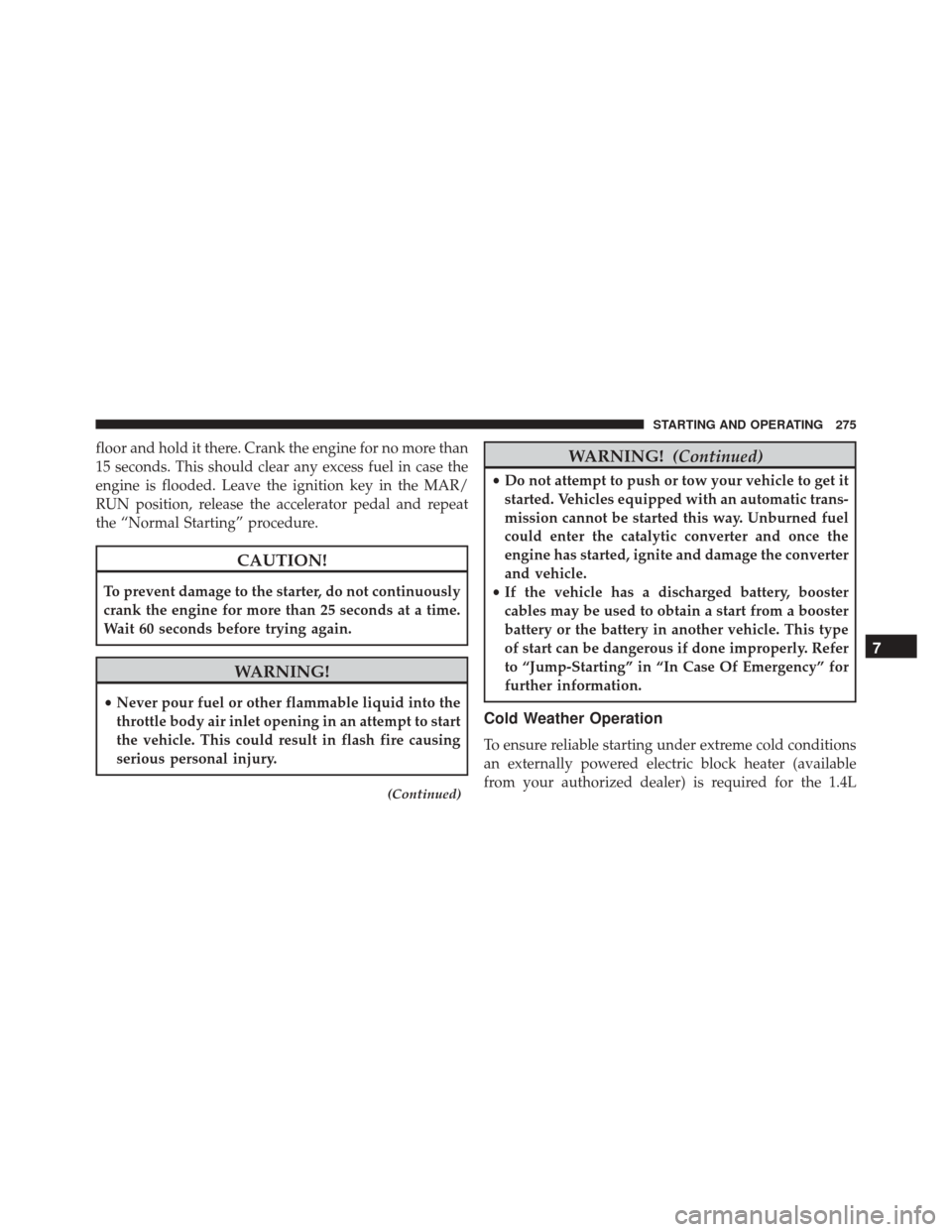
floor and hold it there. Crank the engine for no more than
15 seconds. This should clear any excess fuel in case the
engine is flooded. Leave the ignition key in the MAR/
RUN position, release the accelerator pedal and repeat
the “Normal Starting” procedure.
CAUTION!
To prevent damage to the starter, do not continuously
crank the engine for more than 25 seconds at a time.
Wait 60 seconds before trying again.
WARNING!
•Never pour fuel or other flammable liquid into the
throttle body air inlet opening in an attempt to start
the vehicle. This could result in flash fire causing
serious personal injury.
(Continued)
WARNING! (Continued)
•Do not attempt to push or tow your vehicle to get it
started. Vehicles equipped with an automatic trans-
mission cannot be started this way. Unburned fuel
could enter the catalytic converter and once the
engine has started, ignite and damage the converter
and vehicle.
• If the vehicle has a discharged battery, booster
cables may be used to obtain a start from a booster
battery or the battery in another vehicle. This type
of start can be dangerous if done improperly. Refer
to “Jump-Starting” in “In Case Of Emergency” for
further information.
Cold Weather Operation
To ensure reliable starting under extreme cold conditions
an externally powered electric block heater (available
from your authorized dealer) is required for the 1.4L
7
STARTING AND OPERATING 275
Page 282 of 587

To apply the EPB manually, pull up on the switch
momentarily. You may hear a slight whirring sound from
the back of the vehicle while the EPB engages. Once the
parking brake is fully engaged, the BRAKE warning
lamp in the instrument cluster and an indicator on the
switch will illuminate. If your foot is on the brake pedalwhile you apply the EPB, you may notice a small amount
of brake pedal movement. The EPB can be applied even
when the ignition switch is in the STOP/OFF position
but the BRAKE warning lamp will not illuminate, how-
ever, it can only be released when the ignition switch is in
the MAR/RUN position.
NOTE:
The EPB fault lamp will illuminate if the EPB
switch is held for longer than 20 seconds in either the
released or applied position. The light will extinguish
upon releasing the switch.
If the Auto Park Brake feature is enabled, the EPB will
automatically engage whenever the transmission is
placed into PARK, or with a manual transmission, when
the ignition switch is in the STOP/OFF position. If your
foot is on the brake pedal, you may notice a small amount
of brake pedal movement while the EPB is engaging.
Electric Park Brake Switch
280 STARTING AND OPERATING
Page 283 of 587
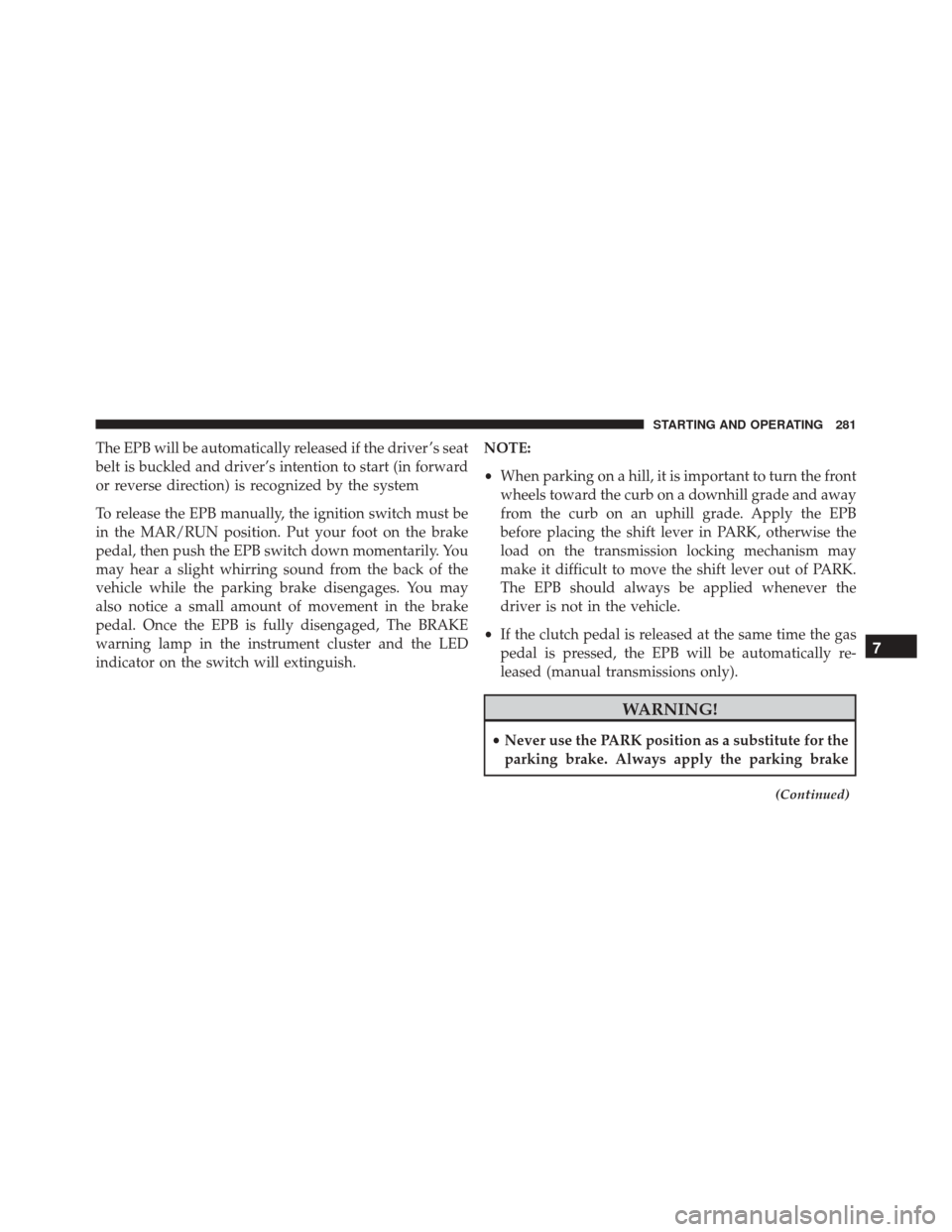
The EPB will be automatically released if the driver ’s seat
belt is buckled and driver’s intention to start (in forward
or reverse direction) is recognized by the system
To release the EPB manually, the ignition switch must be
in the MAR/RUN position. Put your foot on the brake
pedal, then push the EPB switch down momentarily. You
may hear a slight whirring sound from the back of the
vehicle while the parking brake disengages. You may
also notice a small amount of movement in the brake
pedal. Once the EPB is fully disengaged, The BRAKE
warning lamp in the instrument cluster and the LED
indicator on the switch will extinguish.NOTE:
•
When parking on a hill, it is important to turn the front
wheels toward the curb on a downhill grade and away
from the curb on an uphill grade. Apply the EPB
before placing the shift lever in PARK, otherwise the
load on the transmission locking mechanism may
make it difficult to move the shift lever out of PARK.
The EPB should always be applied whenever the
driver is not in the vehicle.
• If the clutch pedal is released at the same time the gas
pedal is pressed, the EPB will be automatically re-
leased (manual transmissions only).
WARNING!
• Never use the PARK position as a substitute for the
parking brake. Always apply the parking brake
(Continued)
7
STARTING AND OPERATING 281
Page 284 of 587
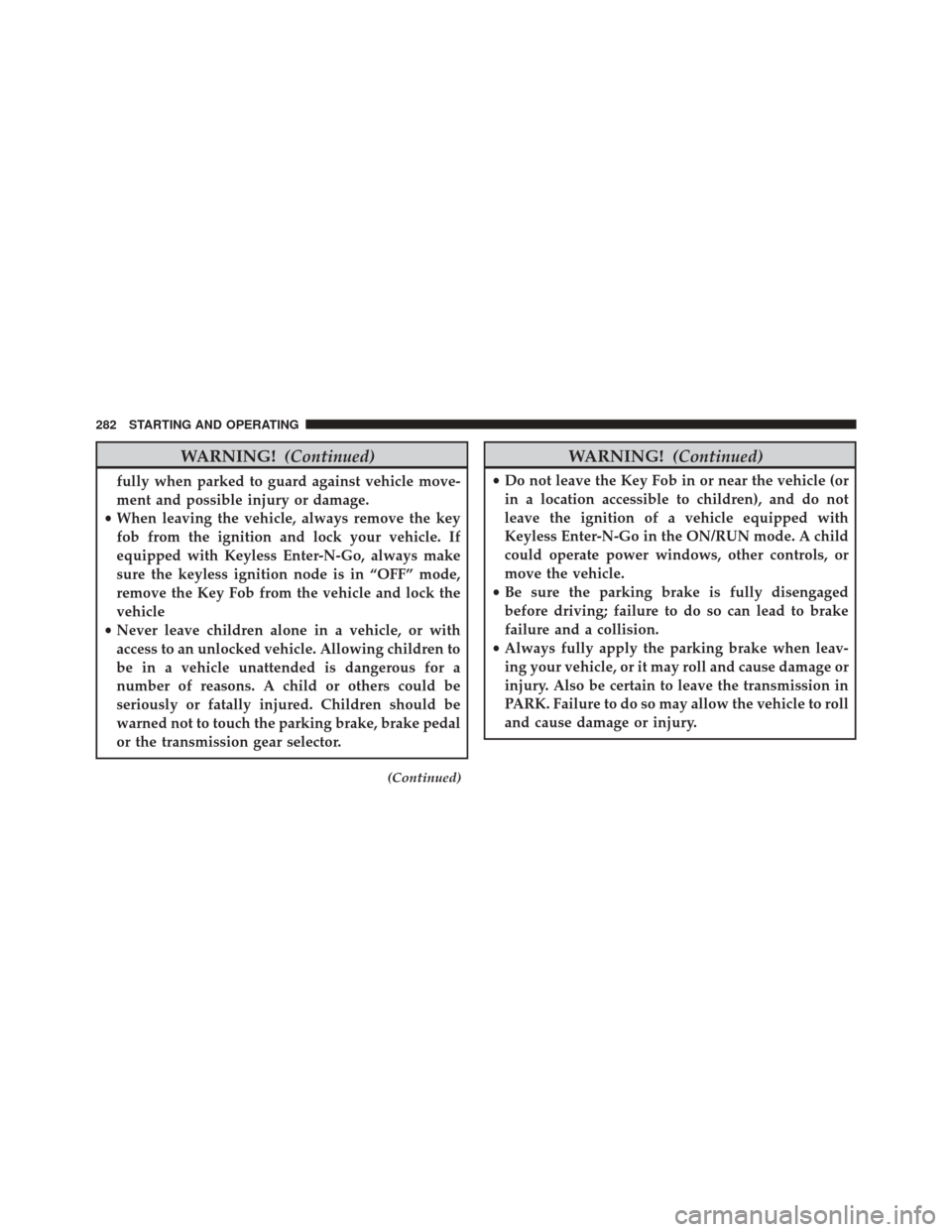
WARNING!(Continued)
fully when parked to guard against vehicle move-
ment and possible injury or damage.
• When leaving the vehicle, always remove the key
fob from the ignition and lock your vehicle. If
equipped with Keyless Enter-N-Go, always make
sure the keyless ignition node is in “OFF” mode,
remove the Key Fob from the vehicle and lock the
vehicle
• Never leave children alone in a vehicle, or with
access to an unlocked vehicle. Allowing children to
be in a vehicle unattended is dangerous for a
number of reasons. A child or others could be
seriously or fatally injured. Children should be
warned not to touch the parking brake, brake pedal
or the transmission gear selector.
(Continued)
WARNING! (Continued)
•Do not leave the Key Fob in or near the vehicle (or
in a location accessible to children), and do not
leave the ignition of a vehicle equipped with
Keyless Enter-N-Go in the ON/RUN mode. A child
could operate power windows, other controls, or
move the vehicle.
• Be sure the parking brake is fully disengaged
before driving; failure to do so can lead to brake
failure and a collision.
• Always fully apply the parking brake when leav-
ing your vehicle, or it may roll and cause damage or
injury. Also be certain to leave the transmission in
PARK. Failure to do so may allow the vehicle to roll
and cause damage or injury.
282 STARTING AND OPERATING
Page 285 of 587
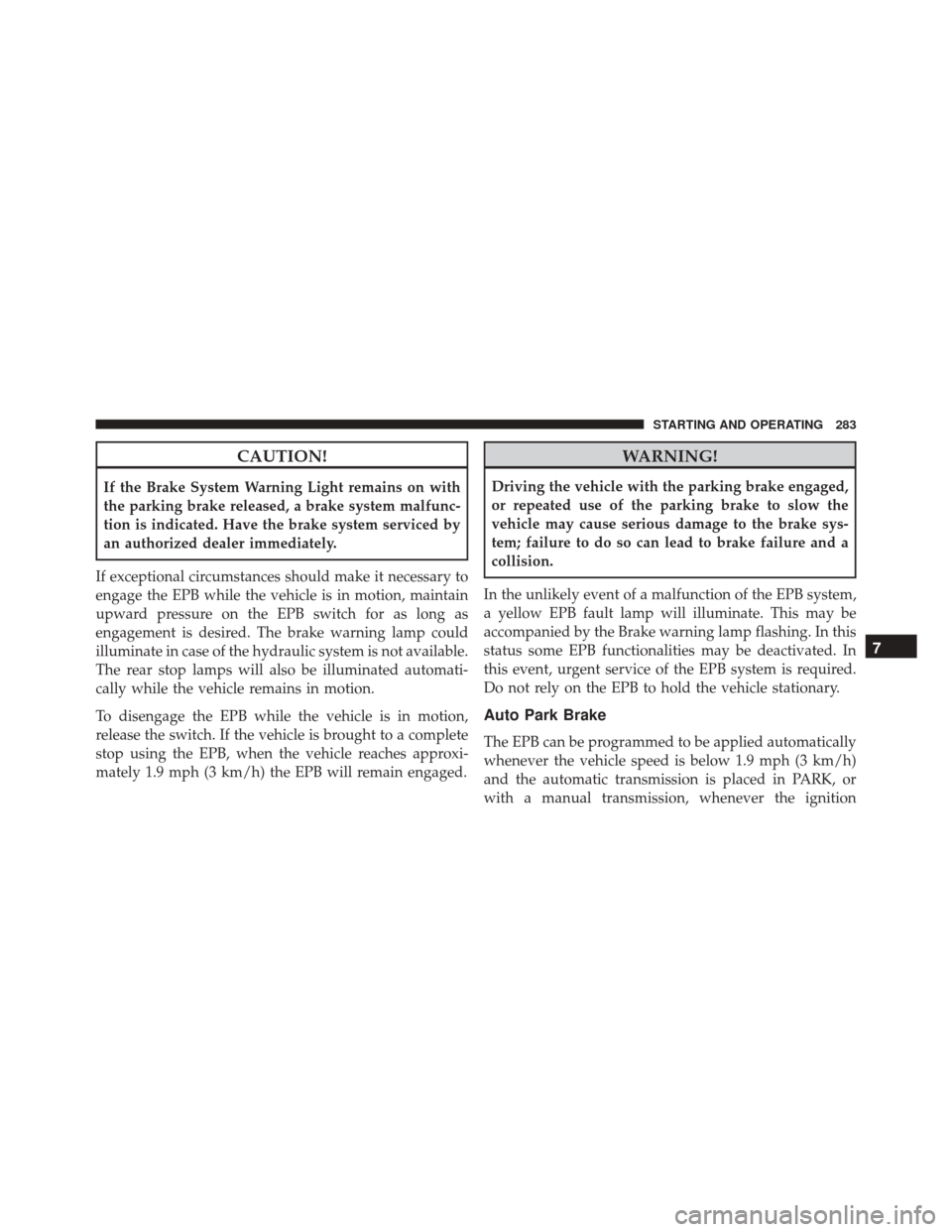
CAUTION!
If the Brake System Warning Light remains on with
the parking brake released, a brake system malfunc-
tion is indicated. Have the brake system serviced by
an authorized dealer immediately.
If exceptional circumstances should make it necessary to
engage the EPB while the vehicle is in motion, maintain
upward pressure on the EPB switch for as long as
engagement is desired. The brake warning lamp could
illuminate in case of the hydraulic system is not available.
The rear stop lamps will also be illuminated automati-
cally while the vehicle remains in motion.
To disengage the EPB while the vehicle is in motion,
release the switch. If the vehicle is brought to a complete
stop using the EPB, when the vehicle reaches approxi-
mately 1.9 mph (3 km/h) the EPB will remain engaged.
WARNING!
Driving the vehicle with the parking brake engaged,
or repeated use of the parking brake to slow the
vehicle may cause serious damage to the brake sys-
tem; failure to do so can lead to brake failure and a
collision.
In the unlikely event of a malfunction of the EPB system,
a yellow EPB fault lamp will illuminate. This may be
accompanied by the Brake warning lamp flashing. In this
status some EPB functionalities may be deactivated. In
this event, urgent service of the EPB system is required.
Do not rely on the EPB to hold the vehicle stationary.
Auto Park Brake
The EPB can be programmed to be applied automatically
whenever the vehicle speed is below 1.9 mph (3 km/h)
and the automatic transmission is placed in PARK, or
with a manual transmission, whenever the ignition
7
STARTING AND OPERATING 283
Page 288 of 587
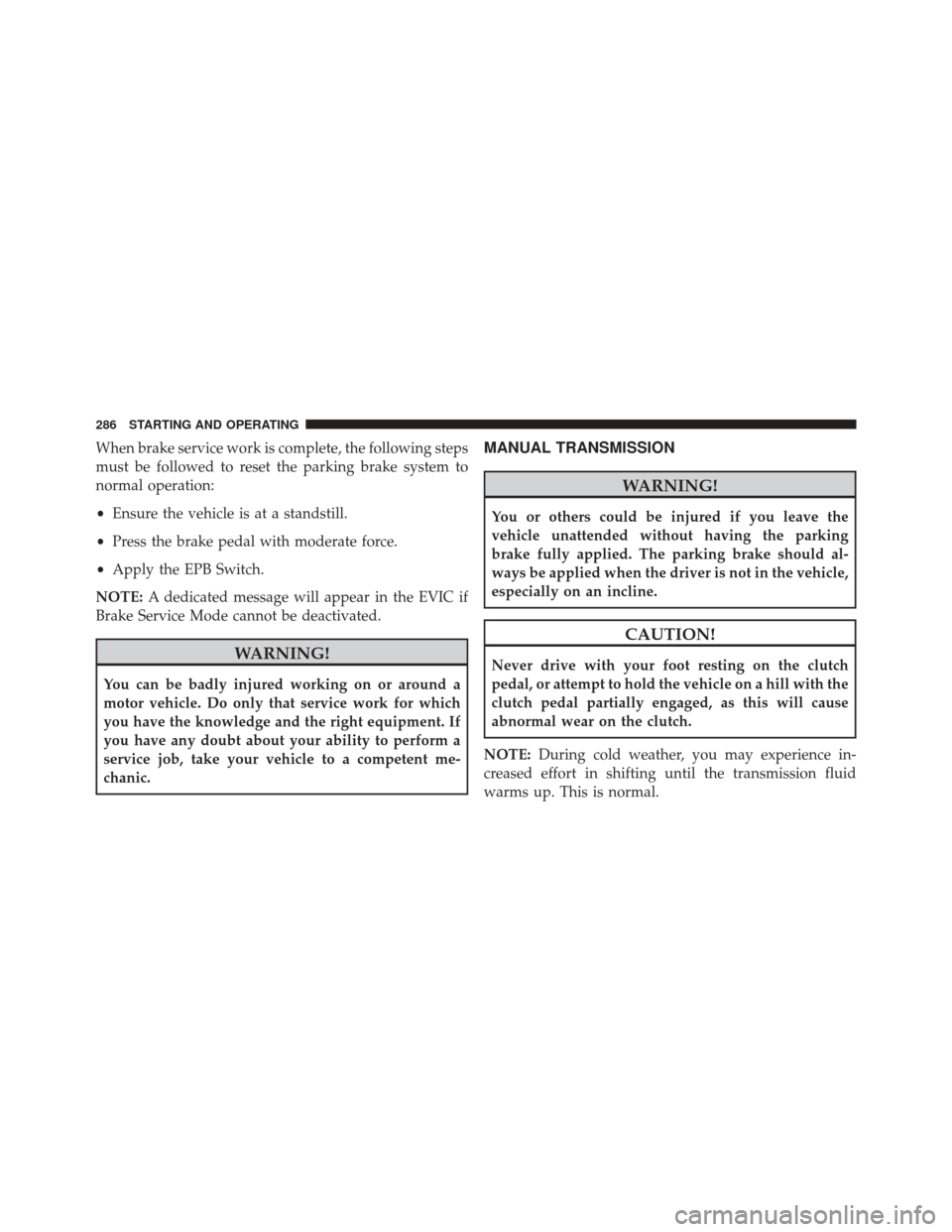
When brake service work is complete, the following steps
must be followed to reset the parking brake system to
normal operation:
•Ensure the vehicle is at a standstill.
• Press the brake pedal with moderate force.
• Apply the EPB Switch.
NOTE: A dedicated message will appear in the EVIC if
Brake Service Mode cannot be deactivated.
WARNING!
You can be badly injured working on or around a
motor vehicle. Do only that service work for which
you have the knowledge and the right equipment. If
you have any doubt about your ability to perform a
service job, take your vehicle to a competent me-
chanic.
MANUAL TRANSMISSION
WARNING!
You or others could be injured if you leave the
vehicle unattended without having the parking
brake fully applied. The parking brake should al-
ways be applied when the driver is not in the vehicle,
especially on an incline.
CAUTION!
Never drive with your foot resting on the clutch
pedal, or attempt to hold the vehicle on a hill with the
clutch pedal partially engaged, as this will cause
abnormal wear on the clutch.
NOTE: During cold weather, you may experience in-
creased effort in shifting until the transmission fluid
warms up. This is normal.
286 STARTING AND OPERATING
Page 290 of 587
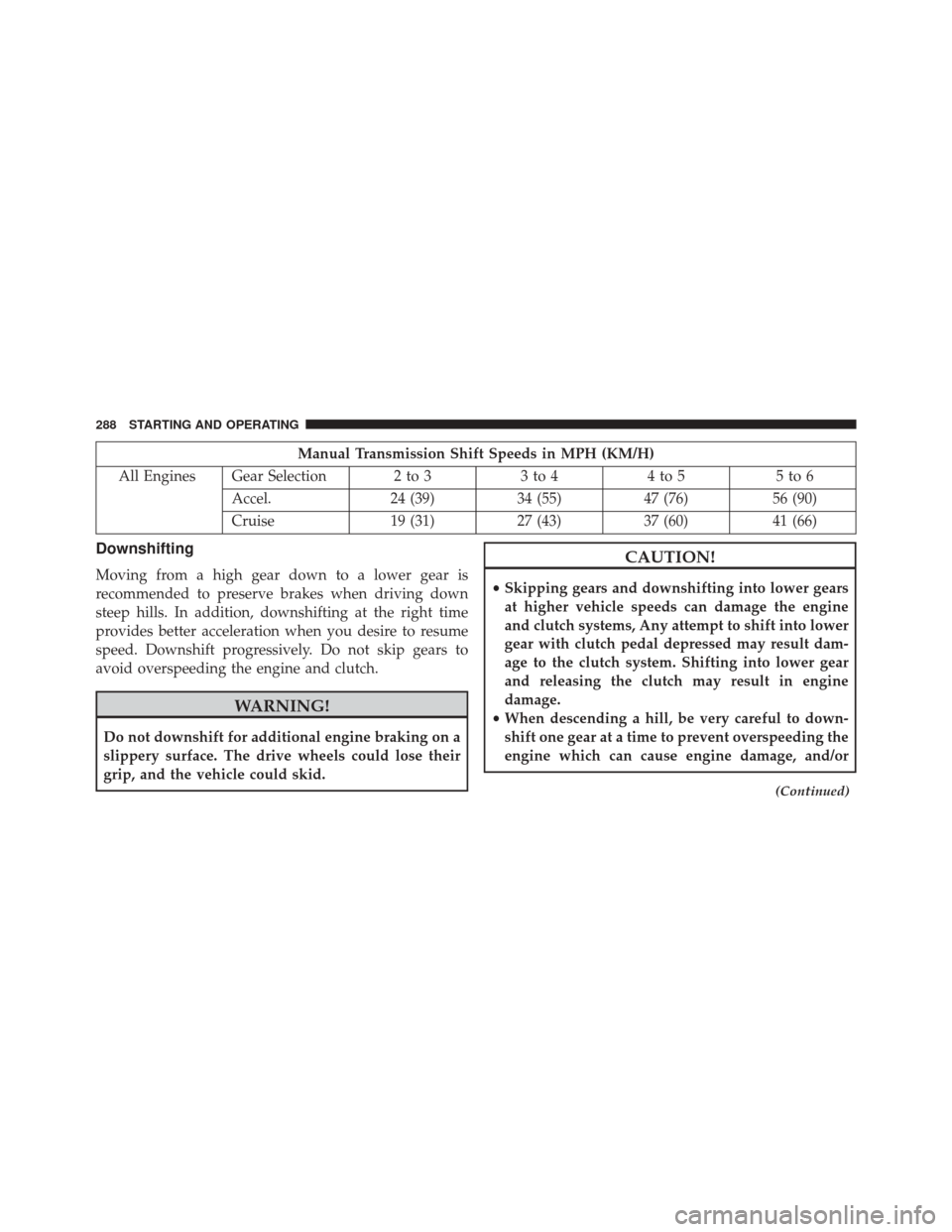
Manual Transmission Shift Speeds in MPH (KM/H)
All Engines Gear Selection 2 to 3 3 to 44 to 5 5 to 6
Accel. 24 (39)34 (55)47 (76) 56 (90)
Cruise 19 (31)27 (43)37 (60) 41 (66)
Downshifting
Moving from a high gear down to a lower gear is
recommended to preserve brakes when driving down
steep hills. In addition, downshifting at the right time
provides better acceleration when you desire to resume
speed. Downshift progressively. Do not skip gears to
avoid overspeeding the engine and clutch.
WARNING!
Do not downshift for additional engine braking on a
slippery surface. The drive wheels could lose their
grip, and the vehicle could skid.
CAUTION!
•Skipping gears and downshifting into lower gears
at higher vehicle speeds can damage the engine
and clutch systems, Any attempt to shift into lower
gear with clutch pedal depressed may result dam-
age to the clutch system. Shifting into lower gear
and releasing the clutch may result in engine
damage.
• When descending a hill, be very careful to down-
shift one gear at a time to prevent overspeeding the
engine which can cause engine damage, and/or
(Continued)
288 STARTING AND OPERATING